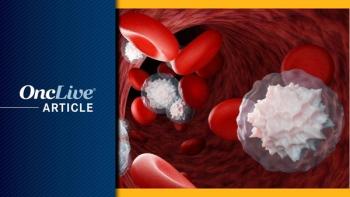
Supplements and Featured Publications
- Research Efforts Underway for RARA+ MDS and AML
- Volume 1
- Issue 1
SELECT-MDS-1: Review of Study Design and Objectives
Gustavo Rivero, MD, comments on the ongoing SELECT-MDS-1 trial and as well as reviewing the adverse events of the potential combination of tamibarotene with azacitidine in patients with higher-risk MDS.
Gustavo Rivero, MD: The study SELECT-MDS-1 represents a significant advance in the way that we perceive the therapy of high-risk myelodysplastic syndrome [MDS]. We can lay out some ideas that might help us understand the rationale of combinational HMAs [hypomethylating agents] plus, the RARA [retinoic acid receptor alpha] inhibitor. I mentioned there is a subgroup of acute myeloid leukemia [AML] and patients with MDS who might overexpress RARA. It's conventionally believed that those patients that are overexpressing RARA might be less sensitive to venetoclax, which is a BCL-2 inhibitor. In the case of MDS it's expected [or] very likely in those patients who are exhibiting high expression of RARA to develop less sensitivity to hypomethylating agents. The combination will come from a set of recent developments, like trying to categorize MDS into 2 subgroups.
So the rationale for combinational HMA plus the RARA inhibitor will regain momentum and relevance if the classification of MDS can go beyond RIPSS-R [Revised International Prognostic Scoring System] only. I mentioned before that MDS could be categorized immunophenotypically as a CMP [common myeloid progenitor]-like disease and a GMP like-disease. CMP is a common myeloid progenitor MDS, and GMP is a granulocyte-monocytic progenitor-like disease. Granulocytic-monocytic progenitor disease is associated to likely have a high grade of RARA expression. This is a monocytic disease that has been historically associated with poor responses to HMAs like venetoclax, so I am predicting that it's likely that monocytic-like disease, MDS disease, might be responsive to this kind of normal combination.
The primary objective would be the overall response rate. And as I mentioned before, we will be able to determine the complete remission rate, the rate of partial remissions and hematologic improvement: erythroid, neutrophil, and platelet. I feel that with the development and the way that it has been strategized, the responses are appropriate.
How do I think azacitidine plus the RARA inhibitor might change the landscape of high-risk MDS? It will be extremely important to keep in mind that subgroup of patients with high-risk MDS, monocytic-like immunophenotypically, might exhibit a high grade of RARA overexpression. This condition might be associated with poor outcomes through a standard therapy of HMA—azacitidine or decitabine. So adding a RARA inhibitor that can stabilize the levels of RARA and induce further differentiation might improve significantly and very likely to respond beyond single-agent azacitidine and decitabine. Side effect-wise, remember for single-agent azacitidine cytopenia has been remarkable from cycle 1 to cycle 4. However, after cycle 4 the degree of cytopenia-transfusion dependency is minimized entirely as MDS-like cells are deleted. For the RARA inhibitor, the number of side effects has not been meaningful. I think grade 1/2 anemia has been described at initial therapy; however, these are not entirely magnified, synergized by the use of azacitidine or decitabine.
So for the side effects of the RARAinhibitor, I briefly mentioned that grade1 or 2 anemia has been described in almost 20% of the patients; however, in combination with azacitidine, it hasn't surpassed that level. A second adverse event is QT prolongation, grade 1 or 2, which has been mostly observed as a single agent. However, in combination with azacitidine, it also hasn’t passed that level.
A whole proportion of patients who are receiving hypomethylating agents in combination with their RARA antagonist experienced differentiation syndrome, which is characterized by a rapid increase in cytokines and is associated with hypoxemia, shortness of breath, swelling, and weight gain. There was some of this, and it is an additional adverse event that we should keep in mind.
Transcript edited for clarity.
Articles in this issue
over 2 years ago
Dr Alfonso Piérola on Unmet Needs in Higher-Risk MDSalmost 3 years ago
Dr Borthakur on the SELECT MDS-1 Trial in Newly Diagnosed MDSover 3 years ago
Future Perspectives in Higher-Risk MDSover 3 years ago
Venetoclax and HMA Resistance in Patients with AML

























































































